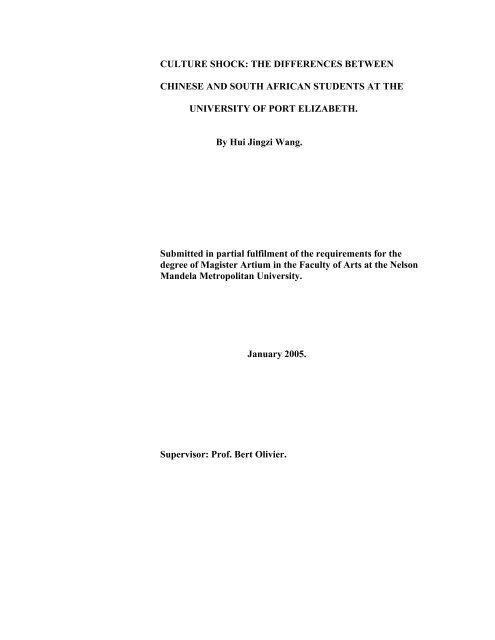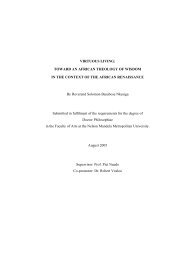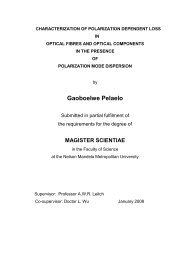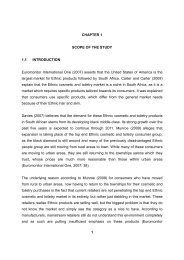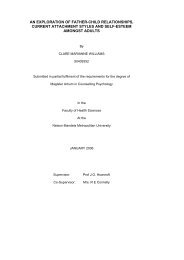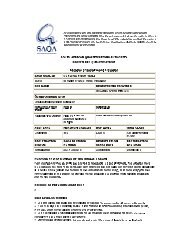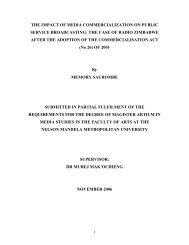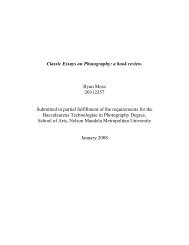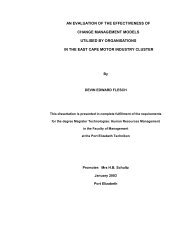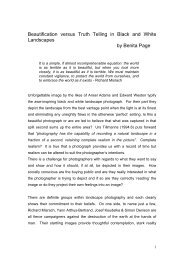CULTURE SHOCK - Nelson Mandela Metropolitan University
CULTURE SHOCK - Nelson Mandela Metropolitan University
CULTURE SHOCK - Nelson Mandela Metropolitan University
Create successful ePaper yourself
Turn your PDF publications into a flip-book with our unique Google optimized e-Paper software.
<strong>CULTURE</strong> <strong>SHOCK</strong>: THE DIFFERENCES BETWEENCHINESE AND SOUTH AFRICAN STUDENTS AT THEUNIVERSITY OF PORT ELIZABETH.By Hui Jingzi Wang.Submitted in partial fulfilment of the requirements for thedegree of Magister Artium in the Faculty of Arts at the <strong>Nelson</strong><strong>Mandela</strong> <strong>Metropolitan</strong> <strong>University</strong>.January 2005.Supervisor: Prof. Bert Olivier.
Port Elizabeth being a port city saw many Chinese students, merchants and traderssettle here. The Chinese originally settled in South End but were relocated to KabegaPark later, in accordance with the Group Areas Act.In a 1987 demographic survey the local Chinese community was calculated at 1350people of whom only 250 resided outside of Kabega Park (Ferreira, 1987). Little or nointeraction takes place between the “Kabega Park community” and those residingelsewhere in Port Elizabeth.With the westernization of the Chinese, especially the younger generation, varioustraditions, rituals and customs fell by the wayside. Traditional values are still held inhigh regard though, especially within and among members of the community itself.Those who have been most affected by South African society, the Port ElizabethChinese, speak two different Chinese dialects, namely Mandarin and Hakka, whichare divided almost equally.There are two formal organizations operating in the Chinese community of PortElizabeth, namely the Eastern Cape Chinese Association (ECCA) and the ChineseCatholic Association. Founded in 1902 the ECCA is the more important associationand functions as community leader. Its duties include the promotion of Chineseculture and welfare within the community.As a community the Chinese are highly disciplined people with great reservations (ifnot resistance) concerning personal and community involvement, which is why theorganizations mentioned earlier play an important role as far as their participation incultural activities is concerned. With the great measure of westernization that hastaken place, though, they seemed to have become more open and communicationallyreceptive towards people outside their insular society.7
<strong>CULTURE</strong>What is Culture?Culture is not an easy concept to define. Scholars emphasize different aspects andcontinue to struggle for a precise focus and meaning. Thus only basic considerationswill be concentrated on here with respect to so complex a notion.A classic definition of culture is Sir Edward Taylor’s early definition (1871) whichviews culture as “that complex whole which includes knowledge, belief, art, morals,law, custom and any other capabilities and habits acquired by man as a member ofsociety” (Guanipa, 1998:1). Thus a culture consists of all the learned patterns ofacting, feeling and thinking shared by the members of a particular society.Each society has a culture differing somewhat from that of all other societies. Asociety is therefore defined as all the people who share a common culture (Oberg,1960:1).A culture is often referred to as a “system” and this term is used to emphasize thedynamic qualities of cultural systems. They grow, shrink, adjust to their surroundings,change, divide, merge and influence each other. The outstanding characteristic of acultural system is that it is a process, it moves (Oberg, 1960:1).The cultural elements of human existence, however, are primarily mental or ideational– the things that count are ideas, meanings and purposes. A piece of chalk may be amaterial artifact, but the important thing about it is what it means or signifies within agiven cultural setting. It may be used in the schoolroom to write symbols on theblackboard or it may hang as an amulet around someone’s neck to ward off evil8
spirits. Scholars generally agree that the key to culture lies in the mind, and that thesemanifestations of culture, or ideas (‘signs’ in semiotic terms), are the foundation ofculture. In this sense culture is thus largely abstract; nonetheless, it is a fundamentalpart of human reality, both material and non-material (Kim, 1988:1).For the purposes of this study it is important to note that the present is an era of‘globalization’, a process that manifests itself at different levels, including thecultural. Some commentators claim that, because of global communicationtechnology connecting all the countries of the world, and the fact that English is thedominant international language, world cultures are becoming more similar or‘homogenized’ (Steger, 2003:70-73). Others argue that, because different cultures(and even different people in the same culture) respond differently to, for exampleAmerican influences, it causes cultural ‘hybridization’, or the appearance of newcultural forms (Steger, 2003:75). The question is then whether, for example, people inChinese culture developing new ways of greeting each other because of exposure towestern forms of greeting, is a case of homogenization or of hybridization (it seems asif it is the former). Steger (2003:76) is of the opinion that both processes (as well asanother, called cultural ‘particularism’, which is often conservative or evenfundamentalist) are occurring at the same time, side by side.As will be noticed from the comparison of Chinese and South African cultures, aswell as from the experiences of Chinese students at the <strong>University</strong> of Port Elizabeth(in the following sections), the effects of cultural globalization can be seen in certainchanging cultural customs. Even the fact that Chinese students studying at foreignuniversities like UPE learn (as will be seen) new skills and new ways of doing things,is an example of intercultural contact and communication in the era of globalization,although it is not easy to say if this is ‘homogenization’ or ‘hybridization’.Chinese Cultural Characteristics9
“Expect the Unexpected, and then enjoy it”. Those “unexpected” experiences,actually, are part of the purpose to travel to China! As a result of his 30 trips toChina, he came to love the country and its people (Zhang, 1991:1)Chinese FestivalsWith a cultural tradition stretching back almost five thousand years the ChineseLunar calendar is filled in its entirety with various traditional festivals andcelebrations, each being totally different from the other. Apart from the majorfestivals marked on the Lunar Calendar, each little town in China boasts its ownfestivals which have accumulated since ancient times---almost every day sees acelebration of one kind or another.Spring festival commemorating the beginning of the Chinese Lunar New Year is thelargest, mot colourful and most prestigious of all the Chinese festivals. This festival,stretching over a period of a few weeks, incorporates various ancient customs suchas: Paying of outstanding debts, dressing up in new clothing, spring-cleaning ofhouses and the presentation of “LUCKY” little red envelopes containing money. Thepreparations start in the old year on the eighth day of the last Lunar moon and end onthe fifteenth day of the first moon of the New Year. During this period huge amountsof food are purchased and consumed. New Year’s Day marks the high point offestivities. Firecrackers and whistling rockets thunder throughout the night and daysymbolically frightening away the fiercest of evil spirits. The strenuous andspectacular Lion-and-Dragon dances are performed from the sixth day of the NewYear.Chinese Eating Customs11
The main difference between Chinese and South African eating habits is that, unlikeSouth Africa, where everyone has their own plate of food, in China the dishes areplaced on the table and everybody shares. If you are being treated by a Chinese host,be prepared for a ton of food. Chinese are very proud of their culture of food and willdo their best to give you a taste of many different types of cuisine. Among friends,they will order just enough for the people there. If they are taking somebody out fordinner and the relationship is polite to semi-polite, then they will usually order onemore dish than the number of guests (e.g. four people, five dishes). If it is a businessdinner or a very formal occasion, there is likely to be a huge amount of food that willbe impossible to finish.A typical meal starts with some cold dishes, like boiled peanuts and mashedcucumber with garlic. These are followed by the main courses, hot meat andvegetable dishes. Finally soup is brought out, which is followed by the starchy"staple" food, which is usually rice or noodles or sometimes dumplings. ManyChinese eat rice (or noodles or whatever) last, but if you like to have your ricetogether with other dishes, you should say so early on.One thing to be aware of is that when eating with a Chinese host, you may find thatthe person is using their chopsticks to put food in your bowl or plate. This is a sign ofpoliteness. The appropriate thing to do would be to eat the whatever-it-is and sayhow “yummy” it is. If you feel uncomfortable with this, you can just say a politethank you and leave the food there, and maybe cover it up with a little rice when theyare not looking. Of course, you should use chopsticks to eat Chinese food. However,one thing you must not do is to stick your chopsticks upright in a bowl of rice. Thishas too much of a resemblance to incense burning in a bowl of sand, as in ceremoniesfor the dead. And you must not wave your chopsticks or use them to point at people;for fear that you can easily poke someone in the eye. It is also impolite to reachacross someone else’s chopsticks when reaching for food.12
It is customary for the host to put down the quality of the food that is being served.However, one should not agree with him or her, even if it’s true. The proper etiquetteis to complement your host profusely instead.In Chinese culture, burping enthusiastically is a sigh of appreciation, as opposed to itbeing regarded as rudeness in South African culture. At banquets, where you may beserved up to twelve courses, try to pace yourself because you are expected to eatsomething from every dish. Again, the ritual is to refuse the first offer of food fromyour host, for fear of appearing to be greedy.Turning a fish over on its plate is considered a bad omen, since it represents thecapsizing of a boat. Instead, the fish bone should be removed from the top to get atthe flesh underneath. You can always leave this to the host or the server.One should be sure to leave some of the noodles or rice behind that is served at theend of a banquet. If you finish it all, it implies that you are still hungry and that thehost has not provided you with enough food. And once the meal is over, you willnotice that all the guests will leave promptly. This is contrary to the South Africancustom of lingering over a cup of coffee.Chinese TeaIn China the use of tea for its healing properties dates back as far as the Stone Age.Later, during the Western Han dynasty (206 B.C. – 220 A.D.), tea as a beveragebecame quite popular, but was reserved for the nobility only. In later dynasties thedrinking of tea became so popular amongst all people that it became one of the“SEVEN NECESSITIES’ of daily life (Lee, 1959:2). Tea houses became verypopular during the Sung dynasty. They were places for meeting and enjoyment withmusical and dancing performances as well as places where major news events werecommunicated.13
Along with these tea houses developed certain etiquette for drinking tea as well asspecial rules and rituals for brewing different kinds of tea. The name “TEA ARTHOUSE”, as it is called in China today was derived from the special ritual performedwhen brewing “OLD MAN’S TEA”.Present day tea houses as seen in China are very much the same as the South Africancoffee shops or houses in appearance, except for the use of Chinese décor and music.They are also ever so popular, being places where friends meet, business negotiationstake place or simply a place where people relax. What makes these tea houses evenmore popular is the availability of tea that one can enjoy, each having its ownmedicinal property, taste and fragrance.Chinese tea is normally served throughout the meal. As a courtesy, the polite host orguest will always top up the cups of those around him or her before topping up his orher own. And to thank each other for the courtesy, they often tap the first two fingersof the right hand on the table. This little gesture apparently dates back to the time ofthe Qing dynasty, when a certain emperor was fond of wandering incognito amonghis people. Since his companions could not bow to the emperor without revealing hisidentity, they devised the finger tapping as a sign of respect. Nowadays, it’s alsoquite practical because one can continue to talk and tap one’s fingers at the sametime.GreetingsAs should already be apparent, food is a very important element of Chinese culture.Therefore, it is no surprise that people routinely greet each other by asking if theyhave eaten yet. The literal translation is: “Have you eaten rice yet?” To which theanswer should be: “Yes, thank you---and you?” It’s the exact equivalent of theEnglish greeting: “How are you?” and the expected response of “Fine, thanks”—even if you are not fine.14
The traditional bow is pretty much out of fashion, except amongst some olderChinese. Today, many Chinese have adopted the western custom of hand shaking,although usually with a lot less enthusiasm. (This could be regarded as somethingsymptomatic of the era of globalization - at the cultural level - which was referred toearlier. In this era there is more contact between different cultures than ever before,and especially American cultural values and customs can be seen as a majorinfluence on other cultures, Chinese culture being no exception.) One should not beoffended if certain Chinese women are still uncomfortable with shaking your hand,however. Hugs and kisses, as a greeting or farewell, are definitely not in line withChinese tradition (as yet) and should be avoided.Most Chinese are born with three names. However, many younger Chinese who havebeen exposed to western culture may add an English name as well (for example---Philip Lee Wing Chan). Traditionally, the Chinese will introduce themselves by theirsurname first, which is the direct opposite of what South African people do. This canoften be a source of confusion, since you may not know for sure if he is in fact Mr.Lee or Mr. Chan. The best way to avoid confusion is to ask. Be aware that manyChinese women have retained their maiden name, a cultural option dating back tolong before the women’s liberation movement in the west, so no one should besurprised if one’s host introduces his wife by a different last name.Many Chinese businessmen now use bilingual business cards, with English on oneside and Chinese on the other (another sign of western cultural influence in aglobalizing world). Business cards are a symbol of professional status, and as a signof respect, the proper etiquette is to present and receive business cards with bothhands.Presenting Gifts15
The Chinese will generally appreciate receiving gifts that are made in the country ofthe visitor’s origin—something unique and practical that cannot be purchased inChina. Nowadays, many Chinese are interested in learning English, so English booksare usually a popular item—including picture books showing scenery from thegiver’s particular area.A few more gift-giving guidelines that reveal a lot about Chinese culture are:Gifts to individuals should be fairly small in value (R20-R100). If one is presentinggifts to more than one individual, make sure that all the gifts are roughly of equalvalue. And one should not omit anyone present or anyone who may have beenhelpful to you during your stay. For this reason, you may want to take a few extragifts along, just in case.Gifts to companies may be of higher value and should be presented to the head of thegroup at a dinner banquet or at the conclusion of a business meeting. Very expensivegifts should be avoided, unless it is a very important business deal.If one is invited to a person’s home, it is common courtesy to bring along a smallgift—again mementos from one’s home country or small toys for the children wouldbe appropriate, along with some fruit. This shows that you are concerned about thewelfare of the entire family and not just interested in a business relationship.It is normal for a Chinese person to refuse a gift two or three times before finallyaccepting it. Accepting a gift without first refusing may be interpreted as a sign ofgreed. However, one should just insist that the gift is a very small token and that onewould be honoured if it was accepted. You may also be presented with a gift that iswrapped, and it is important to remember that it is considered impolite to open it infront of the giver, unless he or she encourages you to do so.One should use the traditional lucky colours of red or gold to wrap gifts, and avoidusing white or black, since they are considered colours of mourning.16
The Chinese also consider it good luck to give things in pairs or even multiples. So ifone is bringing oranges, it is advisable to take along six or eight, instead of an oddnumber. The host will often give back part of the gift to the giver (as in the case oforanges), as a way to return some of the good luck to you.The one gift that one should avoid giving to a Chinese is a clock. In Cantonese,“clock” is a homophone that means “to go to a funeral” and may be construed aswishing death upon the person. Likewise, it is considered bad luck to give sharpobjects such as a knife or scissors because it represents the severing of a friendship.From available verbal information this seems to be a belief shared by many westernpeople. Flowers have traditionally only been given to those in hospitals, or worse, atfunerals. However, this is changing with the times, but the notion of presentingindividual flowers in even numbers still applies.South African Cultural CharacteristicsSouth Africa is undergoing one of the most exciting phases of social and politicalchange, the very nature of which will alter the social structure that has existed for 300years. Old laws have been thrown out and the racist beliefs they underscored arebeing whittled away by new-found values and knowledge (Rissik, 1994:1).Consequently, South Africans are discovering that the generally deep-seated moral orethical values that make up the backbone of almost all societies in the world arecertainly prevalent across the board in this country too. It is only the cultural orreligious differences, superficial by comparison, that identify various groupsdifferently and create exciting cultural diversity.GreetingsThere are ever so many different ways of greeting people in South Africa and muchof it depends on the culture and language of the person or persons concerned. But asa general rule, one should greet people whenever and wherever possible - 99 times17
out of a 100, it is worth the effort, because a visitor’s overriding impression is thatSouth African culture is marked by friendliness.Any traditionally western person is quite accustomed to the quick “good morning” or“good afternoon” as you rush by. In the more traditional African societies much moreimportance is placed on greeting someone and exchanging a few pleasantries, so itmay well be necessary to say a bit more than a rushed “good day” by adding a fewquestions like ‘Is all well today?’ or ‘Is your family well?’ or anything else thatcrosses one’s mind - and one should remember to await the reply and to answer thequestions that are put to you. It costs very little time, yet this kind of communicationbuilds strong bridges and working relationships in a culture where these things arevalued.The Handshake And BeyondWhen meeting a person for the first time in South Africa, men are almost alwaysexpected to shake hands - just grasp right hand to right hand and shake. More oftenwomen meeting men follow this ritual too, while women meeting women may shakehands or may just nod an acknowledgement.In a social situation, once one is more familiar with people, you may find that menwill greet women friends with a kiss on the cheek, while they will greet each otherwith a handshake, and the more daring will give each other a hug. In a businessenvironment it is appropriate for women to greet male colleagues with either a nod ora handshake. A kiss would be a little too familiar for the business community.ChristmasChristmas is a major South African celebration especially because it falls in themiddle of the school and summer holidays. Even the most irreligious tends tocelebrate it by giving gifts and enjoying a special meal with family and friends.18
Newcomers to the country and the community are often invited to join in the familyfestivities of their new-found friends.It may feel rather strange to many, especially anyone from the northern hemisphere,to celebrate Christmas on a hot and sunny day, but that’s the way it is done here. Andmore strange still, is the fact that some South Africans try to approximate that specialwinter-Christmas feeling with cotton wool and polystyrene chips, the most commonimitation of snow. Many South Africans may rarely, if ever, have seen snow!Giving of gifts is certainly part of the Christmas ritual, especially to children. Thetype of gift depends very much on your relationship with the person you are giving itto, but generally something small is appreciated.The major celebration is held during either Christmas Eve dinner or Christmas Daylunch. And for many, especially in the white communities, a fairly traditional BritishChristmas meal of roast turkey and ham with vegetables and chicken pie is served.Dessert includes the traditional Christmas pudding with brandy sauce, mince pies andother sweetmeats, nuts and dried fruit. This feast is washed down with a celebratorydrink like champagne, wine or anything else that takes their fancy.Entertaining – South African StyleMost people here are friendly and hospitable and invitations like ‘you should comeround for a drink’ or ‘pop in any time’ are usually meant sincerely. Casual invitationsto a meal, a barbecue (‘braai’), or perhaps to have a drink with friends on your wayhome from work are common. So one should not be a shrinking violet but take themup on their offers. But one should do it thoughtfully.If one is unsure whether the offer was a serious one, it should be confirmed ahead oftime. Although South Africans are very casual, it is wise to phone a day or two inadvance. Nothing could be more embarrassing than to turn up on their doorstep andfind that they are not expecting you, or worse, not to go, then later to find that they19
had gone to great lengths to invite others to meet you. If the invitation is extended toyou on the spur of the moment and for immediate use, one should just ensure it is notinconvenient and then jump at the chance to enjoy new company.Many South African people will invite one to ‘pop in’ whenever you like. Some willeven suggest you need not bother to phone first. This is often well meant, but untilyou know their family routine, one should call ahead. Arriving at the children’s bathtime can be a bit of a strain on your host, or just ‘popping in’ when they are about tosit down to a meal could be embarrassing.Generally, entertaining South African style revolves around a lot of chit-chat andsome ‘breaking of bread’. If one is invited to do something more formal, like playtennis or a game of bridge, you will usually be told in advance. Since there are asignificant number of private swimming pools in the country, one could just as wellbring along your swimsuit and a towel, especially in the summer.The Official LanguagesBefore the advent of democracy in 1994, English and Afrikaans were South Africa’stwo official languages. This meant that absolutely everything the government had ahand in – government documentation, all matters bureaucratic and all Parliamentarymatters – were conducted/communicated in either or both languages. Since 1994things have changed – there are now 11 official languages, and as can be expected, itis difficult to communicate everything in all of these.Most South Africans can speak either English or Afrikaans, in addition to one or moreof the indigenous languages such as Zulu, Xhosa, Sotho or Tswana. Quite often bothEnglish and Afrikaans are spoken, as South Africans have been taught theselanguages in schools for many decades. But it does not mean that everyone speaks orunderstands them well, so be patient, especially when it is obvious that it is not thespeaker’s native tongue.20
More than 57% of all South Africans can speak English, not necessarily perfectly, noras a first or home language, but still well enough for you to communicate with themin English. Of course accents and even colloquial words may vary but they certainlyadd flavour, and no doubt a good dose of confusion and humour to your interactionwith locals.An equivalent amount of South Africans speak Afrikaans, but it is likely that thepercentage could drop as ever more political refugees return home - most havelearned English while living abroad. As the country re-enters the ‘global scene’, therehas been a growing realisation among South Africans that English is the languages ofinternational communication, especially in the business world.South African CuisineEating, whether at home or eating out, it most often a sociable and shared occasion.Among the western and westernised communities, who are mostly city dwellers,sharing a meal is often done in friendship and in the interests of a good businessrelationship. But in the more traditional, rural, or tribal communities, the sharing offood characterises the spirit of the people and is a cultural tradition to be shared evenwith a stranger and an enemy.Because South African society developed with the arrival of various European andAsian immigrant communities over the centuries, the cuisine has grown out of ahealthy and varied mixture of cultural ideas and flavours, tempered by what waslocally available. The present era of the ‘global village’ has also enabled an everwideningarray of gastronomic variety in the country, making the cuisine as open tochange and experimentation as is the new and developing society.21
FORMULATION OF THE PROBLEMS AND PROBLEMANALYSISThus far this study has approached the cultural differences between Chinese andSouth African students through comparing the two cultures. It has been observed thatthose differences and possible problems relating to them range from practicaldifficulties regarding transport, accommodation and finances to less easily definedissues related to language and culture.Students’ initial Perceptions and Experiences of AdjustmentAs is true for many students, the initial stage of being in South Africa is or wasexciting, challenging and confusing, as they started attending university as soon asthey arrived.Chinese students suffer another type of shock when they study overseas – in this casein South Africa. This is a kind of shock which can be much more serious andpotentially damaging to a student’s ability to study- we call it ‘learning shock’.Learning shock is the realisation by a student that the way he/she has been used tolearning and studying is totally inappropriate to the way courses are taught at overseasuniversities.There are many differences between studying in China and studying in a country suchas South Africa. First of all there is the simple difference of the time it takes tocomplete a programme. This is most marked at postgraduate level. A master’s degreetakes 2-3 academic years to complete in China, while in South Africa it may take onlyone calendar year, although it could take two, or up to three years, depending onwhether it is a coursework master’s programme or a research master’s degree. This22
doesn’t mean that there is less work in the course of doing a South African degree. Itmeans that one’s studying and learning is much more intensive and you have to workmuch harder in what is usually a shorter time.In addition, for some of your time you have to work on your own, and organise anddirect your own learning. Many Chinese students find this especially difficult, as theyare used to having their pattern of study and learning organised for them. At UPE(from 2005 NMMU), for example, you will be expected to plan your learning andorganise your time yourself.The basis of a degree programme in China is to attend lectures, gather information,and show that you have learnt that information by repeating it in a formalexamination. International universities recognise that students learn in different ways,and so there are many more elements to an international programme. Also there ismuch more of an emphasis on how you use the information that you have learnt. So,as well as lectures, you will be expected to attend seminars and tutorials.A seminar consists of a small group of students with a tutor where you can talk aboutany aspect/aspects of recent lectures and discuss other issues that have come out ofthe lectures or from your own personal research. A tutorial is a session between onlyyou and your tutor where you can discuss any issues related to your studying.You will not always be expected to work and learn just on your own. Some aspects ofyour programme will inevitably involve group work. The tutor will set an assignmentand you will be expected to work with three or four colleagues to handle theassignment together.Assignments are a very important part of studying and learning. They give you theopportunity to research important issues so that they can be introduced into yourarguments and discussions. If, when doing an assignment, you only include23
information that your tutor has given you, your marks will be low. He/she will wantyou to introduce other ideas and arguments - ones that you have found out foryourself.However, many Chinese students find it very strange that they might be allowed, oreven be expected, to argue with their tutors. The basis of Chinese teaching has alwaysbeen that one should avoid arguing and debating with the tutor, although there is ofcourse no reason why this should be a problem - in fact it is to be encouraged. Thatway everybody learns and benefits mutually. Chinese students do, however, find itdifficult to argue with tutors, and sometimes even to ask questions. This can give thetutor the wrong impression of the student, as he/she will feel that the student does notunderstand the classes or lectures.Students’ adjustment to examinationsIn the opinion of many of the lecturers interviewed, the good marks their studentsobtained were partly the reflection of the pivotal role of examinations in Chineseschools. There, students are selected even for key elementary schools throughentrance exams, and this practice is repeated in high schools and universities. The factthat even permission to attend advanced classes in a particular school is contingentupon passing an exam places tremendous pressure on students to pursue high marks.For instance, students are used to memorizing verbatim the definitions of concepts,rules and facts to obtain maximum marks. This rote memorization does notnecessarily help them at the <strong>University</strong> of Port Elizabeth (from 2005 the <strong>Nelson</strong><strong>Mandela</strong> <strong>Metropolitan</strong> <strong>University</strong>), and although it may be helpful to quote from thetext in exams, it will not necessarily guarantee the highest marks. As one lecturerexplained, the demands on students are more complex than in the past, and to befamiliar with an issue, students may have to watch TV programmes, read newspapers,magazines or other reference books in order to provide a comprehensive answer to aparticular question.24
Even for a science exam, not all pertinent aspects are discussed in the textbooks. Onestudent mentioned that his social studies teachers liked to ask questions about the'long-term' and the 'short-term' significance of an historical event, aspects that had notalways been addressed by the textbook authors.Nonetheless, another student felt that lecturers in his course did not take exams asseriously as teachers in China did. They did not spend much time helping students toreview the material that had to be covered for the exam, so that students would obtainthe best possible marks. In contrast, Chinese teachers would look at the scores of theirstudents as a means for measuring the quality of their teaching as well as measuringthe ability of their students.English language learning and cultural adjustmentMastering the English language as a means of communication is certainly the majorhurdle for all Chinese students. A lecturer commented as follows on the problemsthey experienced:“Except for the students with disruptive refugee backgrounds who missed much oftheir formal schooling, Chinese students are the group who have the hardest timelearning English. Their main problem is spoken English, whereas they do well ingrammar and understanding. The typical student from China, I can see, can getthrough a demanding reading test with the use of a dictionary, looking words up andgetting the main ideas.”Although English has long been part of the elementary and secondary school curriculain China, the results are mediocre. Students' comments have confirmed the findings ofthe literature. As Wong (1989) has pointed out, (in China) English is taught byteachers for whom English is a foreign language, and many of them are also poorlytrained. Most importantly, Chinese teaching methodology usually lacks the emphasison communicative competence which Western language teachers consider essentialfor effective second language learning.25
Regardless of the level of their initial English proficiency, all Chinese studentsentering South African classrooms are usually placed in an all-English school oruniversity environment. Here their problems in understanding and expressingthemselves in English not only result in difficulties getting decent marks, but also indisorientation in their social lives because of their inability to function effectively inthe spheres of language and culture.One of the female students who had only recently arrived in South Africa actuallywished to return to China after a few weeks. She was depressed and felt so muchstress and loneliness that she was ready 'to throw in the towel'. However, she knewthat her chances to go to university and to study in the subject of her choice weremuch better in South Africa than in China, and so she kept struggling. She had, infact, completed all her credits in mathematics and science and was then able toconcentrate on English and social studies. But she still felt lonely and had a veryrestricted social life. As her lecturer mentioned, her only contact with people her agewas with one or two girls who had attended the same class.The lack of familiarity with South African language(s) and customs on the part ofChinese students has also had its humorous sides. One lecturer recalled, he had toldhis students they could call him about an assignment at night or during the weekend ifneed be, and one of his Chinese students actually did call him -- in the middle of thenight.For other student participants, adjustment to South African culture was less'hazardous'. One student said he was very enthusiastic learning English andparticipating in his peer culture: his room was full of youth magazines, and the wallswere decorated with posters of popular athletes and movie stars. Talking to his peerswas an important means of learning both language and culture, and therefore he spentmuch of his time with his local friends after attending university or on weekends.Another student recalled his two years of learning English:26
“I did not start making very close friends until I moved to the accommodation of theuniversity. By then I had graduated from my language course. My English was goodenough for my classes, but I still had problems expressing my feelings andcommunicating with others. I made three close friends during that time, and I learneda lot from them. . . . [In UPE] the classes were not that tough, except for Englishwhere I had an average of seventy percent. I had learned many new things aboutEnglish literature, including word choice, grammar and sentence structure. After thatyear, my English mark rose to eighty-five per cent. . . . Looking back through my twoyears here, there are stresses and happiness. I don't know exactly how I adjusted toSouth African schooling, but I remember I was even afraid to go out when I had justarrived here. Now I feel good about myself like anyone else.”Researchers in second language acquisition point out that, while Chinese studentsusually learn adequate social functioning in English within two years, it typicallytakes one or two years for them to catch up to grade norm in academic performance inEnglish (Ashworth, 1975; Wong, 1989). Lecturers must therefore be cautious indeducing how well a Chinese student has adjusted. Zhang (1991) reported that manyadult Chinese students may reach a desirable level of writing competency but remainpoor in oral fluency after years of studying in English. Most of the studentsapproached in the course of the present study also mentioned that they usuallyreceived a lower mark for oral presentations than for written assignments.Adjustment to social studies and extra-curricular activitiesChinese students are seen as being weak in social studies. According to onecounsellor, some of them lacked background knowledge in certain areas such as thehistory of western countries. In addition, lecturers pointed at the differences betweenSouth African and Chinese teaching methods. They saw Chinese pedagogy as beingmore traditional, more like the schools in North America decades ago:27
“The criteria for education are broad. For example, in history you need a good thesistopic, analytical and critical thinking. Traditionally, you only needed goodbackground knowledge which you can get from reading books. Another aspect ismastering the spoken language through class presentations. However, the demands arenow much higher than they were in the 1950's. You have to argue and defend youropinions.”Chinese students were less involved than their fellow students in extra-curricularactivities or other after-school programmes. Some of the lecturers remarked that theyusually see their Chinese students in the library or in the computer room, andoccasionally they play badminton or work on a fine arts project: "They perhaps do nothave time or do not have the same interests as others", explained one lecturer.This explanation was confirmed by most Chinese students who mentioned that thepopular sports in China were table tennis, badminton, soccer and basketball, ratherthan hockey, baseball or football. Another student confessed that he did not feelcomfortable participating in sports that involved too much body contact.Lecturers' perceptions and concernsThe lecturers participating in the study generally held favourable views of theirChinese students, and they seemed to appreciate certain elements of Chineseeducation such as the development of a good work ethic and the effectivetransmission of basic skills and knowledge, since these elements were seen as theessential function of the school. On the other hand, they had some reservationsregarding the students' limited involvement in extra-curricular activities. In general,however, lecturers felt there were both high and low achievers among their Chinesestudents as much as in any other cultural group. The fact that their families' socioeconomicbackground is highly influential in students' academic achievement wasseen as being confirmed in the case of their Chinese students, but, in the lecturers'opinion, it also applied to students from other ethnic backgrounds.28
For instance, as one lecturer remarked, other South African students were by nomeans lagging behind Chinese students in terms of academic achievement, althoughthe latter tended to score higher in mathematics in some cases. As he saw it,“We try to develop a child from a whole range instead of simply passing on theknowledge from textbooks. . . To me, the Chinese way of educating the student todaysounds more like the practice twenty or thirty years ago in South Africa.”In particular, UPE put emphasis on developing students' verbal ability and researchskills. They learn to select research topics, check information sources, interviewpeople, etc. These positive aspects were acknowledged by the participating Chinesestudents, who were amazed by their own learning experiences at the <strong>University</strong> ofPort Elizabeth such as field work, class presentations and many other in-classactivities. (In view of what was said earlier about intercultural experiences in the eraof globalization, this can be seen as a good example of one culture influencing peoplebelonging to another culture in such a way that their ways of doing things change inimportant respects.) Even for a lab report in a chemistry class a South African lecturerwould let students develop their ideas fully and ask them to write a comprehensivereport, whereas a Chinese teacher would, in all likelihood, have students fill in theblanks on a work sheet.The teaching of mathematics was a topic of special interest because the scope and theproficiency of students' mathematics skills are (globally) of great importance in anincreasingly technological society. "As math teachers we are concerned about ourstudents," one teacher explained:“I have to go through a kind of circle to bring them along. Some students spend aconsiderable amount of time on fractions. We don't get the bare bones of twelve yearsworth of time. As we repeat things twice or three times, students begin to loseconcentration.”29
In his opinion, mathematics, like many other subjects, should teach the fundamentals.After more than thirty years of teaching, he felt that his approach was ratherconsistent with teaching mathematics in China, and he preferred the traditionalteaching method because of the nature of mathematics as a subject.RESULTS AND DISCUSSIONHow to interpret the findings?Despite the fact that Chinese students experience South African universities as beingvery different from those in China, these students enjoyed their new experiences andwere happy to associate with their local friends and lecturers. After overcoming thelanguage barrier in a relatively short time, they tend to study hard and generally dowell in their academic pursuits as they were taught throughout their childhood.According to their lecturers, they had good attendance records, were conscientious inhanding in their assignments, asked questions in and out of class (a sign that they haveadapted to different cultural expectations), and usually ranked among the top twentyper cent in their class, especially in mathematics: Only on a few occasions did theirreport cards show marks of 60%, mainly due to the difficulties they encountered whentaking English for the first time, and they generally aimed at no single subject beinglower than 75%.The finding that these Chinese youths appeared to adjust rather smoothly to SouthAfrican universities may need more elaboration. Apart from all the positive factorsthat make adjustment less stressful, Lysgaard (1955) mentions the possibility thatpositive memories generate a sense of optimism when an individual experiences anew cultural environment:“We cannot refute for certain the possibility that it is really not adjustment that isgeneralized, but the memory or perception of this adjustment: One may not30
emember, or perhaps, one did not at the time perceive, failures in one instance ifsuccess was achieved in some others. There may be a tendency to register only thegood things. Or, if certain failures were especially prominent, one may have forgotten,or did not even at the time perceive, successes that one really had in other instances”(p.48).For these Chinese students, their personal aspirations played an important part inshaping their attitudes towards their academic studies and their behaviour atuniversity. Their previous school experience in China helped them in their successfuladjustment as well. In particular, they had at an early age internalized the emphasis onlearning as serious and hard work had been required through the rigorous learningmethods in their Chinese schools, especially in the studying of mathematics.In the area of English or language and the arts, the initial difficulties wereconsiderable for these Chinese students. First of all, all of the participating studentshad very limited communication skills in the English language, which can beattributed to the rather lopsided language learning methods they had been exposed to,which emphasize grammar and translations rather than communicative competence.Secondly, it is likely that it is more difficult for a Chinese to learn English than forother international students since there is a major difference between (Chinese)logographs and the alphabet.With regard to social studies and the humanities, these Chinese students at UPEenjoyed the opportunity to be creative in what and how they learned, despite the factthat many of them still had difficulties in expressing themselves in class presentations.Some of the students mentioned their interest in the study of history since historyprovided them with a better understanding of Western society.To sum up, through comparing the cultural differences between Chinese and SouthAfrican students at UPE, we have found that one positive result of the experience ofstudying abroad (in this case on the part of Chinese students) is the ability to31
understand your own culture and society better through observing another. Another islearning new skills from another culture and in this way enriching your own. Cultureshock in the time of globalization will only be a shock to you if you arriveunprepared. If you study abroad expecting things to be different, and have a positiveattitude that you can change yourself, then you should have no problems living andstudying overseas.BIBLIOGRAPHYGuanipa, Dr Carmen.1998. Amigos-Culture Shock. USA. San Diego State <strong>University</strong>.Human, L. 1984. The Chinese People of South Africa. Pretoria. Unisa.Kim, Y.Y. 1988. Communication and cross-cultural adaptation: An integrative theory.Philadelphia: Multilingual Matters.Lee, S.K.J.1959. Chinese Art. Cape Town. <strong>University</strong> of Cape Town.Leedy, Paul D. 1993. Practical Research: Planning and Design. Fifth Edition. UpperSaddle River. NJ: Prentice Hall.Lysgaard, S. 1955. Adjustment in a foreign society egian Fulbright Grantees visitingthe United States. International Social Science Bulletin.Mouton J and HC Marais. 1990. Basic Concepts in the Methodology of the SocialSciences. Pretoria: Human Sciences Research Council.Oberg, K. 1960. Culture shock. Adjustment to new cultural environments. PracticalAnthropology, 7.32
Ogbu, J.U. 1983. Minority status and schooling in plural societies. ComparativeEducation Review, June.Rissik, Dee. 1994. Culture Shock! South Africa. London. Kuperard Ltd.Steger, M.B. 2003. Globalization. A very short introduction. Oxford. Oxford<strong>University</strong> Press.Wong, J.L. 1989. The Overseas Student: Expatriate,Sojourner or Settler?Orlando:Academic Press.Zhang, L. 1991. Adjustment experience of PR China graduate students. Unpublishedmaster's thesis, <strong>University</strong> of Saskatchewan, Saskatoon.33


